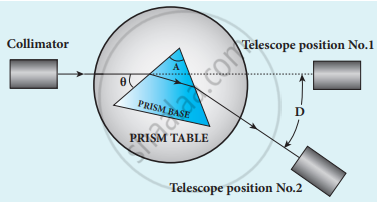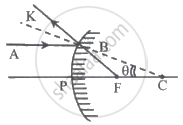Advertisements
Advertisements
Question
Explain the experimental determination of the material of the prism using a spectrometer.
Solution
- Angle of the prism (A)

Angle of prism
- The prism is placed on the prism table with its refracting edge facing the collimator.
- The slit is illuminated by a sodium light (monochromatic light). The parallel rays coming from the collimator fall on the two faces AB and AC.
- The telescope is rotated to the position T1 until the image of the slit formed by the reflection at the face AB is made to coincide with the vertical cross wire of the telescope.
- The readings of the verniers are noted. The telescope is then rotated to the position T2 where the image of the slit formed by the reflection at the face AC coincides with the vertical cross wire. The readings are again noted.
- The difference between these two readings gives the angle rotated by the telescope, which is twice the angle of the prism. Half of this value gives the angle of the prism A.
- Angle of minimum deviation (D):
- The prism is placed on the prism table so that the light from the collimator falls on a refracting face, and the refracted image is observed through the telescope. The prism table is now rotated so that the angle of deviation decreases.
- A stage comes when the image stops for a moment and if we rotate the prism table further in the same direction, the image is seen to recede and the angle of deviation increases.
- The vertical cross wire of the telescope is made to coincide with the image of the slit where it turns back. This gives the minimum deviation position.

Angle of minimum deviation - The readings of the verniers are noted. Now, the prism is removed, and the telescope is turned to receive the direct ray and the vertical cross wire is made to coincide with the image. The readings of the verniers are noted.
- The difference between the two readings gives the angle of minimum deviation D. The refractive index of the material of the prism n is calculated using the formula,
n = `sin("A+D"/2)/sin("A"/2)`
APPEARS IN
RELATED QUESTIONS
Answer the following question in detail.
How does magnifying power differ from linear or lateral magnification?
Answer the following question in detail.
Derive an expression for the magnifying power of a simple microscope. Obtain its minimum and maximum values in terms of its focal length.
Answer the following question in detail.
Obtain the expressions for magnifying power and the length of an astronomical telescope under normal adjustments.
Answer the following question in detail.
What is the limitation in increasing the magnifying powers of a compound microscope?
Discuss about simple microscope and obtain the equations for magnification for near point focusing and normal focusing.
Why is oil-immersed objective preferred in a microscope?
What is the use of an erecting lens in a terrestrial telescope?
What are the uses of spectrometer?
What is myopia?
What is hypermetropia?
What is presbyopia?
Obtain the equation for resolving the power of the microscope.
Mention different parts of the spectrometer.
A compound microscope has a magnification of 30. The focal length of eye piece is 5 cm. Assuming the final image to be at least distance of distinct vision, find the magnification produced by the objective.
A light wave of wavelength λ is incident on a slit of width d. The resulting diffraction pattern is observed on a screen at a distance D. If linear width of the principal maxima is equal to the width of the slit, then the distance D is
When a convex lens of 12.5 cm focal length is used as a magnifying glass, normal eye can see an object clearly at a distance of 25 cm. The magnifying power of the instrument is ____________.
The magnifying power of a telescope is high if its objective and eyepiece have respectively ______.
An observer looks at a distant tree of height 10 m with a telescope of magnifying power of 20. To the observer the tree appears:
In the adjoining figure, AB represents the incident ray, and BK is the reflected ray. If angle BCF = θ, then ∠BFP is given by ______.

